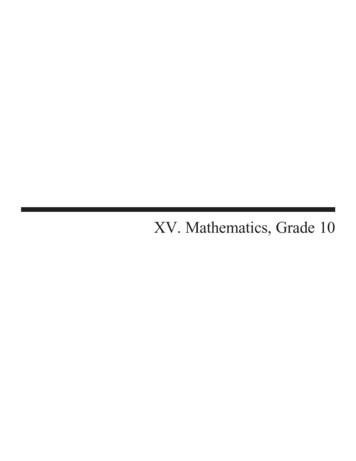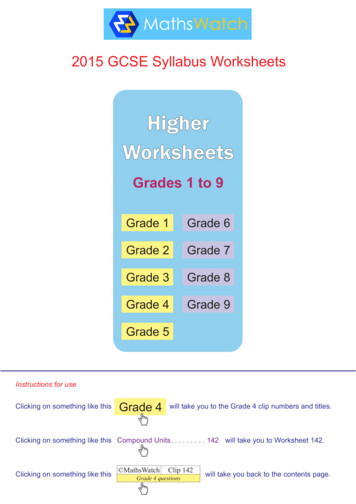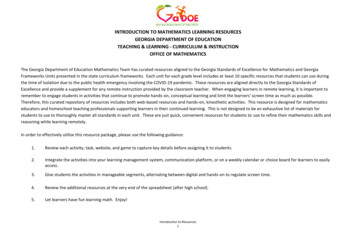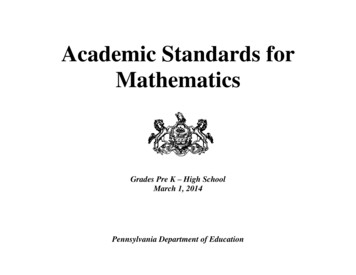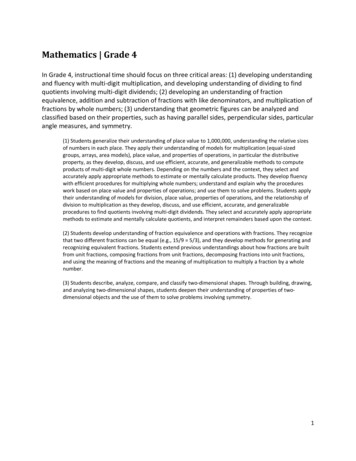
Transcription
Mathematics Grade 4In Grade 4, instructional time should focus on three critical areas: (1) developing understandingand fluency with multi-digit multiplication, and developing understanding of dividing to findquotients involving multi-digit dividends; (2) developing an understanding of fractionequivalence, addition and subtraction of fractions with like denominators, and multiplication offractions by whole numbers; (3) understanding that geometric figures can be analyzed andclassified based on their properties, such as having parallel sides, perpendicular sides, particularangle measures, and symmetry.(1) Students generalize their understanding of place value to 1,000,000, understanding the relative sizesof numbers in each place. They apply their understanding of models for multiplication (equal-sizedgroups, arrays, area models), place value, and properties of operations, in particular the distributiveproperty, as they develop, discuss, and use efficient, accurate, and generalizable methods to computeproducts of multi-digit whole numbers. Depending on the numbers and the context, they select andaccurately apply appropriate methods to estimate or mentally calculate products. They develop fluencywith efficient procedures for multiplying whole numbers; understand and explain why the procedureswork based on place value and properties of operations; and use them to solve problems. Students applytheir understanding of models for division, place value, properties of operations, and the relationship ofdivision to multiplication as they develop, discuss, and use efficient, accurate, and generalizableprocedures to find quotients involving multi-digit dividends. They select and accurately apply appropriatemethods to estimate and mentally calculate quotients, and interpret remainders based upon the context.(2) Students develop understanding of fraction equivalence and operations with fractions. They recognizethat two different fractions can be equal (e.g., 15/9 5/3), and they develop methods for generating andrecognizing equivalent fractions. Students extend previous understandings about how fractions are builtfrom unit fractions, composing fractions from unit fractions, decomposing fractions into unit fractions,and using the meaning of fractions and the meaning of multiplication to multiply a fraction by a wholenumber.(3) Students describe, analyze, compare, and classify two-dimensional shapes. Through building, drawing,and analyzing two-dimensional shapes, students deepen their understanding of properties of twodimensional objects and the use of them to solve problems involving symmetry.1
ContentsMathematics Grade 4. 1Operations and Algebraic Thinking4.OA .4Use the four operations with whole numbers to solve problems. (4.OA.A) . 5Gain familiarity with factors and multiples. (4.OA.B) . 13Generate and analyze patterns. (4.OA.C) . 16Number and Operations in Base Ten4.NBT . 20Generalize place value understanding for multi-digit whole numbers. (4.NBT.A) . 20Number and Operations—Fractions4.NF . 29Extend understanding of fraction equivalence and ordering. (4.NF.A) . 29Build fractions from unit fractions by applying and extending previous understandings of operationson whole numbers. (4.NF.B) . 34Understand decimal notation for fractions, and compare decimal fractions. (4.NF.C) . 41Measurement and Data4.MD . 46Solve problems involving measurement and conversion of measurements from a larger unit to asmaller unit. (4.MD.A). 46Represent and interpret data. (4.MD.B) . 53Geometric measurement: understand concepts of angle and measure angles. (4.MD.C) . 54Geometry4.G . 58Draw and identify lines and angles, and classify shapes by properties of their lines and angles.(4.G.A) . 58Performance Task Example:752
Grade 4 OverviewOperations and Algebraic Thinking Use the four operations with whole numbers tosolve problems.Gain familiarity with factors and multiples.Generate and analyze patterns.Number and Operations in Base Ten Generalize place value understanding for multi-digitwhole numbers.Use place value understanding and properties ofoperations to perform multi-digit arithmetic.Mathematical Practices1.Make sense of problems andpersevere in solving them.2.Reason abstractly and quantitatively.3.Construct viable arguments andcritique the reasoning of others.4.Model with mathematics.5.Use appropriate tools strategically.6.Attend to precision.7.Look for and make use of structure.8.Look for and express regularity inrepeated reasoning.Number and Operations—Fractions Extend understanding of fraction equivalenceand ordering.Build fractions from unit fractions by applyingand extending previous understandings ofoperations on whole numbers.Understand decimal notation for fractions, andcompare decimal fractions.Measurement and Data Solve problems involving measurement andconversion of measurements from a larger unit toa smaller unit.Represent and interpret data.Geometric measurement: understand concepts ofangle and measure angles.Geometry Draw and identify lines and angles, and classifyshapes by properties of their lines and angles.3
Operations and Algebraic Thinking4.OAExample: The two-eyed space creatures, three-eyed space creatures, and four-eyed space creatures are having acontest to create a group with 24 total eyes. How many two-eyed space creatures are needed to make a group with 24 total eyes?How many three-eyed space creatures are needed to make a group with 24 total eyes?How many four-eyed space creatures are needed to make a group with 24 total eyes?Somebody told the five-eyed space creatures that they could not join the contest. Explain why five-eyedspace creatures cannot make a group with 24 eyes.Sample Top-Score Response:12, 8, 6The five-eyed aliens can only make groups with eyes in a multiple of 5. 5, 10, 15, 20, 25. They will not beable to make a group with 24 eyes.For full credit (3 points): The response demonstrates a full and complete understanding of communicating reasoning. Theresponse contains the following evidence: The student correctly identifies the correct number of two-, three-, and four-eyed aliens needed tomake a group with 24 eyes.AND The student correctly explains that the five-eyed aliens cannot make a group with 24 eyesbecause 5 is not a factor of 24 or because the groups of eyes can only be multiples of 5.For partial credit (2 points):The response demonstrates a reasonable understanding of communicating reasoning. Theresponse contains the following evidence: The student identifies one or two correct numbers of the two-, three-, or four-eyed aliens neededto make a group with 24 eyes.AND The student correctly explains that the five-eyed aliens cannot make a group with 24 eyesbecause 5 is not a factor of 24 or because the groups of eyes can only be multiples of 5.OR The student identifies the correct number of two-, three-, and four-eyed aliens needed to make agroup with 24 eyes.OR The student correctly explains that the five-eyed aliens cannot make up a group with 24 eyesbecause 5 is not a factor of 24 or because the groups of eyes can only be multiples of 5.For partial credit (1 point):The response demonstrates a partial understanding of communicating reasoning. The responsecontains the following evidence: The student identifies one or two of the correct numbers of two-, three-, or four-eyed aliens4
ItemClaim#313needed to make a group with 24 eyes.ORThe student does not provide explanation for why the five-eyed aliens cannot make a group with24 eyes.DomainTargetDOKCONTENT3B, 2D23.OA.2, 4.OA.3, 4.OA.4MPKey12,8,6Use the four operations with whole numbers to solve problems. (4.OA.A)a.Item#1Example: Tanya ran 400 meters on Tuesday. She ran 800 meters on Wednesday.What is the total number of meters Tanya ran on these two days?Claim1DomainOA, NBTTargetADOK2CONTENT4.OA.A, 4.NBT.B.4MPN/AKey12005
1.Interpret a multiplication equation as a comparison, e.g., interpret 35 5 7 as a statement that 35 is 5times as many as 7 and 7 times as many as 5. Represent verbal statements of multiplicative comparisons asmultiplication equations. (4.OA.A.1) (DOK 1,2)a. Example: Solution (DOK 2)b.Example: Solution (DOK 1)c.Example: Scott is reading a book that has 172 pages. Melanie is reading a book that has three timesas many pages as Scott’s book.How many pages does Melanie’s book have? Select all the equations that represent this problem.6
,3.OA.B.6MP4KeyMultiply or divide to solve word problems involving multiplicative comparison, e.g., by using drawingsand equations with a symbol for the unknown number to represent the problem, distinguishingmultiplicative comparison from additive comparison. 1 (4.OA.A.2) (DOK 1,2)a. Example: Solution (DOK 2)See Glossary, Table 2.7
b.Example: Some students are painting this backdrop for the school play.The backdrop is taped off into 12 equal sections for the students to paint.ItemMark paints 2 times as much as Jill.Sam paints 3 times as much as Lou.Lou paints 1 section less than Mark.1Jill paintsof the backdrop.12Write the fraction of the backdrop that still needs painted.Claim#274c.Item#21Item#15NF, OADOKA2CONTENTMP4.NF.B, AKey. 6Example: The cost of buying a movie is 4 times the cost of renting a movie. It costs 20 to buya movie. What is the cost, in dollars, of renting a movie?Claim1e.TargetExample: A cat has 2 times as many toys as a puppy. The cat has 12 toys.How many toys does the puppy A.2MPN/AKey5Solve multistep word problems posed with whole numbers and having whole-number answersusing the four operations, including problems in which remainders must be interpreted.Represent these problems using equations with a letter standing for the unknown quantity.Assess the reasonableness of answers using mental computation and estimation strategiesincluding rounding. (4.OA.A.3) (DOK 1,2,3)a. Example: Solution (DOK 2)8
b.Example: Solution (DOK 3)c.Example: Nicole is helping set up tables in the cafeteria.Each table in the cafeteria seats 8 students.Fourth grade students must fill a whole table before sitting at another table.There are 126 fourth grade students.Nicole needs to know how many seats might be empty at the last table after all 126students are sitting at the table.She used these steps to solve the problem:9
Which equation could be Nicole’s Step 3 if she solved the problem correctly?1. 8-6 22. 6 15 213. 6x8 484. 18/6 4.OA.A.3MP1, 3Key1Example: A teacher gives 6 students some cards to play a game. She has 52 cardstotal.The teacher gives each student 1 card until all 52 cards are gone.How many students get exactly 9 cards?1. 22. 43. 54. 6DomainOAe.DOK3TargetADOK2CONTENT4.OA.A.3MP1, 2Key2Example: (Former NAEP question) (DOK 2)On the number line below, what is the sum of the numbers to which the arrows X, Y,and Z point?E. 1,491F. 1,515G. 1,530H. 1,545Answer: F. 1,515f.Example: (Former NAEP question) (DOK 3)Raynold had 31 baseball cards. He gave the cards to his friends. Six of his friendsreceived 3 cards each. Seven of his friends received 1 card each. The rest received 2cards each. How many of his friends received exactly 2 cards from Raynold?Explain how you found your answer.Answer: 3 of his friends received exactly two cards. If six of his friends received 3cards each that leaves (31-18 ) 13 cards. If you take away 7 more cards for the sevenfriends you are left with (13-7 ) 6 cards. If he wants to give exactly two cards to therest of his friends he must have (6 2 ) 3 friends.g.Example: (Former NAEP question) (DOK 3)10
An amusement park has games, rides, and shows. The total number of games, rides, and shows is 70. There are 34 rides. There are two times as many games as shows.How many games are there?How many shows are there?Use numbers, words, or drawings to show how you got your answer.Answer: Games: 24, Shows: 12 I came to this answer by 70 – 34 36. After that it wasa matter of figuring out how to get two numbers that would add up to 36 and thatwould have one double the other.h.Example: (Former NAEP question) (DOK 3)A student had to multiply 328 X 41. The student’s answer was 4,598.Use estimation to explain why this answer is not reasonable.Answer: If you multiply this 328 and 41 by estimating it to 300 by 40, the answerwould be around 12,000 not 4, 600.i.Example: (Former NAEP question) (DOK 2)Ms. Kim has 45 stickers that she wants to give out to 6 students. The students aresitting in a circle. Ms. Kim gives out one sticker at a time and keeps going around thecircle until all the stickers are gone. How many of the students will get more than 7stickers?A. 2B. 3C. 5D. 6Answer: B. 3j.Example: (Former NAEP question) (DOK 2)Five classes are going on a bus trip and each class has 21 students. If each bus holdsonly 40 students, how many buses are needed for the trip?11
Answer: 3 busesk.Example: (Former NAEP question) (DOK 2)Stickers come in small booklets of 100 and in rolls of 1,000. On the store shelf, thereare 6 booklets and 4 rolls of stickers. How many stickers are on the shelf?A. 1,100B. 4,600C. 6,400D. 10,000Answer: B. 4,600l.Example: (Former NAEP question) (DOK 2)There are 20 boxes of pencils in a case. Each box has the same number of pencils. Thecase has 420 pencils altogether. How many pencils are in each box?Answer: 21 pencils in each box12
Gain familiarity with factors and multiples. (4.OA.B)5.Find all factor pairs for a whole number in the range 1–100. Recognize that a whole number is amultiple of each of its factors. Determine whether a given whole number in the range 1–100 is amultiple of a given one-digit number. Determine whether a given whole number in the range 1–100 isprime or composite. (4.OA.B.4) (DOK 1)a. Example: Solution (DOK 3)b.Example: Marcia read books over the summer. She created the picture graph shown.13
Create another picture graph that shows these data with a different key. You may use wholebooks and half books in your graph.Select the key you will use.Color in the books to complete your picture graph.Item#5Claim4DomainMD, OA, P1, 6KeyExample: (Former NAEP question) (DOK 1)Which factor of 12 is missing in this list of numbers?1, 2, 3, 4, , 12A. 5B. 6C. 814
D. 10Answer: B. 6d.Example: (Former NAEP question) (DOK 1)On the chart, circle all the numbers that have 4 as a factor.Answer: Circle: 1, 2, 4e.Example: Which of these numbers is a prime number? (Former NAEP question) (DOK1)A. 6B. 27C. 67D. 81Answer: 67f.Example: (Former NAEP question) (DOK 1)Which of the following true statements proves that 119 is not a prime number?A. 17 x 7 119B. 119 x 1 119C. 119 is greater than 100.D. 119 is an odd number.E. 119 is not divisible by 3Answer: A. 17 X 7 119g.Example: (Former NAEP question) (DOK 1)A certain even number is divisible by 9. This number is between 100 and 120. What isthe number?Answer: 108h.Example: (Former NAEP question) (DOK 1)The numbers 20 and 22 have a common factor. What is the common factor?A. 2B. 4C. 20D. 22E. 440Answer: A. 215
i.Example: Which of these numbers is a prime number? (Former NAEP question) (DOK1)A. 15B. 23C. 34D. 56Answer: B. 23Generate and analyze patterns. (4.OA.C)6.Generate a number or shape pattern that follows a given rule. Identify apparent features of the patternthat were not explicit in the rule itself. For example, given the rule "Add 3" and the starting number 1,generate terms in the resulting sequence and observe that the terms appear to alternate between oddand even numbers. Explain informally why the numbers will continue to alternate in this way. (4.OA.C.5)(DOK 1,2)a. Example: Solution (DOK 3)16
Item#17b.Example: Solution (DOK 3)c.Example: A pattern is generated using this rule:Start with the number 7 as the first term and add 5.Write numbers in the boxes to complete the AKey17
d.Example: (Former NAEP question) (DOK 1)Fill in the four missing numbers on the number line below.Answer: 2,960, 2,970 3,000, 3, 010e.Example: (Former NAEP question) (DOK 1)The table below shows the number of edges for each prism. What is the number ofedges for a prism if the bottom face has 7 sides?1. 182. 203. 214. 22Answer: 3. 21f.Example: (Former NAEP question) (DOK 2)Every 30 minutes Dr. Kim recorded the number of bacteria in a test tube.18
Which best describes what happened to the number of bacteria every 30 minutes?A. The number of bacteria increased by 500.B. The number of bacteria increased by 1,000.C. The number of bacteria doubled.D. The number of bacteria tripled.Answer: C. The number of bacteria doubledg.Example: (Former NAEP question) (DOK 2)Write the next two numbers in the number pattern.1 6 4 9 7 12 10Write the rule that you used to find the two numbers you wrote.Answer: 15, 13 Rule: Plus 5 minus 219
Number and Operations in Base Ten 24.NBTGeneralize place value understanding for multi-digit whole numbers. (4.NBT.A)1.2Recognize that in a multi-digit whole number, a digit in one place represents ten times what it represents inthe place to its right. For example, recognize that 700 70 10 by applying concepts of place value anddivision. (4.NBT.A.1) (DOK 1)a. Example: Solution (DOK 2)Grade 4 expectations in this domain are limited to whole numbers less than or equal to 1,000,000.20
b.Example: Solution (DOK 2)c.Example: Select the statement that explains how the values of the numbers 420 and 4,200 aredifferent.1. 4,200 is 1000 times as large as 4202. 4,200 is 100 times as large as 4203. 4,200 is 10 times as large as 4204. 4,200 is 1 time as large as A.1MPN/AKey3Read and write multi-digit whole numbers using base-ten numerals, number names, and expanded form.Compare two multi-digit numbers based on meanings of the digits in each place, using , , and symbolsto record the results of comparisons. (4.NBT.A.2) (DOK 1)21
a.Example: Solution (DOK 1)b.Example: Select True or False for each comparison.TrueItem#18c.Claim11.5 hundreds 4 tens 50 4002.524 50 200 4003.50 tens 20 ones eyExample: (Former NAEP question) (DOK 1)Which set of numbers is listed from the smallest to largest?Answer: Dd.Example: (Former NAEP question) (DOK 1)Which of the following numbers is five million, eighty thousand?1. 5,800,0002. 5,008,0003. 5,000,0084. 5,080,00022
5. 580,000Answer: 4. 5,080,0003.Use place value understanding to round multi-digit whole numbers to any place.(4.NBT.A.3) (DOK 1)a.Example: Solution (DOK 3)b.Example: Solution (DOK 2)c.Example: Solution (DOK 3)23
Use place value understanding and properties of operations to perform multi-digit arithmetic. (4.NBT.B)1. Fluently add and subtract multi-digit whole numbers using the standard algorithm. (4.NBT.B.4) (DOK 1)a. Example: Write one number in each box to complete the subtraction problem TENT4.NBT.B.4MP1KeyExample: Write the AKey497924
c.Item#1d.Example: Tanya ran 400 meters on Tuesday. She ran 800 meters on Wednesday. 1200What is the total number of meters Tanya ran on these two days?Claim1DomainOA, NBTTargetADOK2CONTENT4.OA.A, 4.NBT.B.4MPN/AKey1200Example: (Former NAEP question) (DOK 2)Sam’s school is trying to collect one million pennies.Write this amount as a number.pennies.So far, the school has collected 513, 462 pennies. How many more pennies does the school need tocollect to reach one million?pennies.Answer: 1,000,000 pennies, 486,538 penniese.Example: (Former NAEP question) (DOK 1)What number is 10,000 more than 333,333?1. 333,4332. 334,3333. 343,3334. 433,333Answer: 4. 433,333f.Example: (Former NAEP question) (DOK 1)Add: 20,000 790,000 g. 792,000h. 810,000i. 811,000j. 990,000Answer: h. 810, 000g. Example: (Former NAEP question) (DOK 1)Subtract:6,090-4,8431. 1,1472. 1,2473. 2,2574. 2,85325
Answer: 2. 1,247h.Example: (Former NAEP question) (DOK 1)What number is 10 more than 5,237?1. 5,2382. 5,2473. 5,3374. 6,237Answer: 2. 5,247i. Example: (Former NAEP question) (DOK 1)By how much will the value of the number 4,372 increase if the 3 is replaced with a 9?1. 62. 603. 6004. 6,000Answer: 3. 600j. Example: (Former NAEP question) (DOK 1)Which of these would be easiest to solve by using mental math?1. 65.12- 28.192. 358 x 23. 1,625 34. 100.00 10.00Answer: 4. 100.00 10.00k.Example: (Former NAEP question) (DOK 3)Dianne found the torn piece of paper shown below.Six numbers originally appeared in a column on this paper. The fourth number from the top of the columnhad been completely torn away. Dianne wondered whether the sum of the six numbers was odd or even.Give an example of a number that could be the fourth number in the column if the sum of the six numbersis an odd number.26
Answer:Explain why you chose that number.Answer: I would make the fourth number an odd number. Because the numbers as is are going to be even,if you want an odd number than you would need to add an odd number onto the paper.2.Multiply a whole number of up to four digits by a one-digit whole number, and multiply two two-digitnumbers, using strategies based on place value and the properties of operations. Illustrate and explain thecalculation by using equations, rectangular arrays, and/or area models. (4.NBT.B.5) (DOK 1,2)a. Example: Solution (DOK 2)b.Item#26a.Write the unknown number that makes the equation true.i. 36 x 94 2700 ? 540 ey120Example: (Former NAEP question) (DOK 1)Patty expects that each tomato plant in her garden will bear 24 tomatoes. If there are 6 tomato plantsin her garden, how many tomatoes does she expect?1. 42. 183. 304. 144Answer: 4. 144b.Example: (Former NAEP question) (DOK 1)74X161.2.9051827
3.4.1,1641,184Answer: 4. 1,1843.Find whole-number quotients and remainders with up to four-digit dividends and one-digit divisors, usingstrategies based on place value, the properties of operations, and/or the relationship betweenmultiplication and division. Illustrate and explain the calculation by using equations, rectangular arrays,and/or area models. (4.NBT.B.6) (DOK 1,2)a. Example: Solution (DOK 3)b.Example: (Former NAEP question) (DOK 1)Park School has 316 students. For field day, the students are put into 4 teams with the samenumber of students on each team. How many students are on each team?1.2.3.4.793123201,264Answer: 1. 79c.Example: (Former NAEP question) (DOK 1)476 5 1. 85 R12. 95 R13. 964. 135 R1Answer: 2. 95 R128
Number and Operations—Fractions 34.NFExample: Jared is testing how much weight a bag can hold. He plans to put juice bottles into three bags. He wantseach bag to have a total weight within a given range. Draw juice bottles into each bag so that the weight is within the given range. Leave the bag empty if the given range is not possible using juice NF.4cKey0,3,4Example: Five friends ordered 3 large sandwiches. James ate ¾ of a sandwich.Katya ate ¼ of a sandwich.Ramon ate ¾ of a sandwich.Sienna ate 2 4 of a sandwich.How much sandwich is left for Oscar?ItemClaim#292DomainTargetDOK2A, 2D1CONTENTMP4.NF. 3Key¾Extend understanding of fraction equivalence and ordering. (4.NF.A)1.3Explain why a fraction a/b is equivalent to a fraction (n a)/(n b) by using visual fraction models, withattention to how the number and size of the parts differ even though the two fractions themselves are thesame size. Use this principle to recognize and generate equivalent fractions. (4.NF.A.1) (DOK 1,2,3)a. Example: Solution (DOK 3)Grade 4 expectations in this domain are limited to fractions with denominators 2,3, 4, 5, 6, 8, 10, 12, and 100.29
b. Example: Solution (DOK 3)c. Example: Figure A has23of its whole shaded gray.2Decide if each fraction is equal to . Check Yes or No for each fraction.330
Item#11Claim1DomainNFd. Example: Figure A hasTargetF412DOK12.Claim1DomainNFMPN/AKeyof its whole shaded.Write another fraction that is equal A.1MPN/AKey1/3 or equivalentCompare two fractions with different numerators and different denominators, e.g., by creating commondenominators or numerators, or by comparing to a benchmark fraction such as 1/2. Recognize thatcomparisons are valid only when the two fractions refer to the same whole. Record the results ofcomparisons with symbols , , or , and justify the conclusions, e.g., by using a visual fraction model.(4.NF.A.2) (DOK 1,2,3)a. Example: Write one fraction in each box to create two true comparisons.31
Key𝟐𝟐𝟑𝟑𝟏𝟏 𝟐𝟐,𝟑𝟑𝟓𝟓𝟒𝟒 𝟔𝟔(Other correct responses arepossible)b. Example: Select True or False for each 4.NF.A.2c. Example: A student claims that all fractions greater thanShow that the student’s claim is only sometimes true.MPN/A37Keyhave a denominator less than 7.Write one number in each box to create a fraction greater than37with a denominator less than 7.32
Write one number in each box to create a fraction greater thanthan 2, 337with a denominator greaterKeyd. Example: (Former NAEP question) (DOK 1)Which fraction has a value closest to 1/2?Answer: A.33
Build fractions from unit fractions by applying and extending previous understandings ofoperations on whole numbers. (4.NF.B)1.Example: Some students are painting this backdrop for the school play.The backdrop is taped off into 12 equal sections for the students to paint.Mark paints 2 times as much as Jill.Sam paints 3 times as much as Lou.Lou paints 1 section less than Mark.1Jill paintsof the backdrop.12Write the fraction of the backdrop that still needs painted.ItemClaimDomainTarget#274NF, OAADOK2CONTENT4.NF.B, 4.OA.A.2MPKey22. Understand a fraction a/b with a 1 as a sum of fractions 1/b.a. Understand addition and subtraction of fractions as joining and separating parts referring to thesame whole.b. Decompose a fraction into a sum of fractions with the same denominator in more than one way,recording each decomposition by an equation. Justify decompositions, e.g., by using a visualfraction model. Examples: 3/8 1/8 1/8 1/8 ; 3/8 1/8 2/8 ; 2 1/8 1 1 1/8 8/8 8/8 1/8.c. Add and subtract mixed numbers with like denominators, e.g., by replacing each mixed numberwith an equivalent fraction, and/or by using properties of operations and the relationship betweenaddition and subtraction.3. Solve word problems involving addition and subtraction of fractions referring to the same whole and havinglike denominators, e.g., by using visual fraction models and equations to represent the problem. (4.NF.B.3)(DOK 1,2,3)a. Example: Solution (DOK 2)34
b. Example: Solution (DOK 3)c. Example: Solution (DOK 2)d. Example: Solution (DOK 2)35
e. Example: Solution (DOK 2)f.Example: Solution (DOK 1)45g. Example: Michael eats of a bag of crackers. Erin eats of a bag of crackers.66Part A: Color in the spaces on the model to show how many bags of crackers Michael and Erineat together.Part B: Circle the total number of bags of crackers Michael and Erin eat together.36
/AKeyh. Example: Check all the numbers that make this inequality true.a.1b.4c.108112 ? 1 888837
.B.3MP7KeyExample: (Former NAEP question) (DOK 1)Change the following mixed numeral to an improper fraction.Answer: 17/84.Apply and extend previous understandings of multiplication to multiply a fraction by a whole number.a. Understand a fraction a/b as a multiple of 1/b. For example, use a visual fraction model torepresent 5/4 as the product 5 (1/4), recording the conclusion by the equation 5/4 5 (1/4).b. Understand a multiple of a/b as a multiple of 1/b, and use this understanding to multiply a fractionby a whole number. For example, use a visual fraction model to express 3 (2/5) as 6 (1/5),recognizing this product as 6/5. (In general, n (a/b) (n a)/b.)c. Solve word problems involving multiplication of a fraction by a whole number, e.g., by using visualfraction models and equations to represent the problem. For example, if each person at a partywill eat 3/8 of a pound of roast beef, and there will be 5 people at the party, how many pounds ofroast beef will be needed? Between what two whole numbers does your answer lie? (4.NF.B.4)(D
Mathematics Grade 4 . In Grade 4, instructional time should focus on three critical areas: (1) developing understanding and fluency with multi-digit multiplication, and developing understanding of dividing to find quotients involving multi-dig

